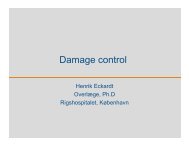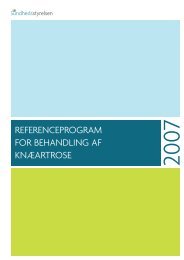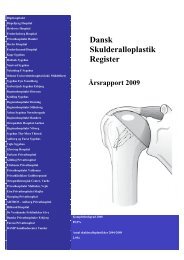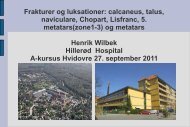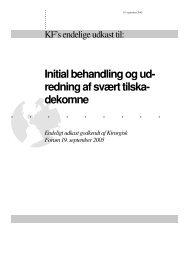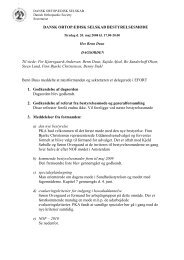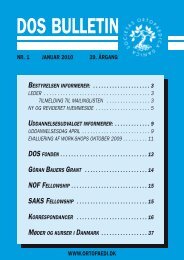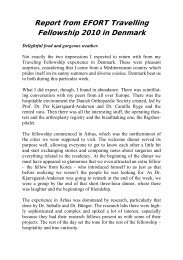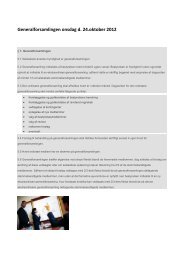DOS BULLETIN - Dansk Ortopædisk Selskab
DOS BULLETIN - Dansk Ortopædisk Selskab
DOS BULLETIN - Dansk Ortopædisk Selskab
You also want an ePaper? Increase the reach of your titles
YUMPU automatically turns print PDFs into web optimized ePapers that Google loves.
2010-378_<strong>DOS</strong> nr. 3 2010 29/09/10 10:08 Side 135<br />
Can “high flex” be achieved and does it matter in<br />
total knee arthroplasty?<br />
A randomized, controlled trial<br />
Morten Grove Thomsen, Henrik Husted, Kristian Otte, Anders Troelsen<br />
Dept. of Orthopedics, University Hospital of Hvidovre, Denmark<br />
Background: Pain free range of motion (ROM) is a cornerstone in successful<br />
total knee arthroplasty (TKA). The achievement of a high degree<br />
of knee flexion is thought to improve the activity in daily living and possibly<br />
the patient satisfaction.<br />
Purpose: The purpose was to compare ROM, patient satisfaction, pain,<br />
“feel” of the knee, and activities of daily living between a standard posterior<br />
cruciate- retaining TKA and a “high flex” posterior-stabilized<br />
TKA.<br />
Methods: The study is a randomized, single-blinded, controlled trial in<br />
which patients undergoing one-stage bilateral TKA randomly had a standard<br />
AGC (Biomet®) cruciate-retaining TKA in one knee and a Highflex<br />
LPS (Zimmer®) posterior-stabilized TKA in the contra lateral knee.<br />
At follow-up 6 weeks, 3, 6 and 12 months postoperatively, the ROM, satisfaction,<br />
pain, “feel” of the knee, and the abilities in daily activities<br />
were assessed. The study group consisted of 33 patients (mean age: 67.2<br />
yrs). The knees had comparable preoperative ROM.<br />
Findings: At 1-year follow-up we found a significantly higher degree of<br />
knee flexion of 7°, both active and passive, in the “high-flex” group (p=<br />
0.001). The “high-flex” LPS TKA showed a mean active flexion of 121°<br />
(range: 105°-140°) and passive flexion of 127° (range: 107°-146°). In<br />
both groups the median VAS pain score was 0, the median VAS satisfaction<br />
score was 9, and the median VAS score of the patient “feel” of<br />
the knee was 9 at 1-year follow-up. Further, there were no significant<br />
differences between the groups in the performance of daily activities.<br />
Conclusion: The “high-flex” TKA showed increased knee flexion, but<br />
no significant differences in patient related outcomes were found. This<br />
suggests little clinical relevance of the difference in knee flexion as pain<br />
free ROM and high patient satisfaction were achieved with both TKA’s.<br />
135



